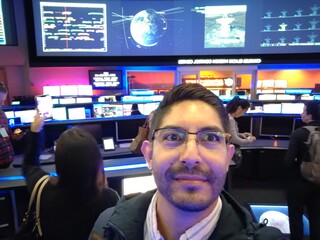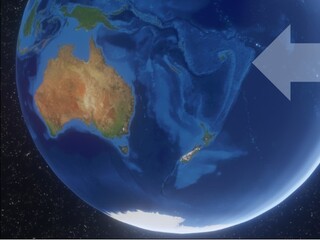Everyone has a different path to JPL.
For Lee-Lueng Fu, it started on a summer’s day in 1979, while he was working as an oceanographer in a tiny sea-swept town on the Atlantic. A very excited satellite engineer showed up, unspooling a roll of film. He told anyone who would listen that a new satellite had just captured more information about the ocean in 100 days than all the ships on the planet had captured in the preceding 100 years.
That satellite, Seasat, was built by JPL. To be sure, it malfunctioned after three months. But Lee was intrigued by this satellite that had managed to outshine so much in so short a time. He wanted to take its potential further, and joined JPL soon afterwards.
Forty years later, in 2019, Theresa Dardar was waiting patiently on the coast of her own sea-swept town on the Gulf of Mexico, wrapped in a coat against a cold spring day. Theresa, an Elder of the Pointe-au-Chien tribe, watched for hours as volunteers loaded sacks of oyster shell into boats, stacking them so heavily that Theresa thought the boats might sink. That band of volunteers had gathered for a seacoast protection project.
Lee and Theresa have never met, but they’ve both lived their lives with their eyes on the ocean – just in different ways. Lee has spent his four decades at JPL dedicated to ocean satellites: one satellite for every decade. Each has been an increasingly advanced follow-up mission to Seasat (and none of them broke after three months). These satellites are called altimeters: they use radar to study the ocean.
One piece of information returned from altimeters stands out over the decades: the height of the ocean has gone up almost everywhere in the world.
Back on the Gulf of Mexico, people like Theresa can attest to this, just in a different way. Both she and Rosina Philippe, an Elder of the Atakapa-Ishak/Chawasha tribe, Grand Bayou, advocate for coastal communities as President of the Lowlander Center and President of the First People’s Conservation Center, respectively. They may not build ocean satellites, but they are eyewitnesses to changes on their own stretch of shoreline. Rosina’s community, for example, has lived for centuries on the little fingers of land on Louisiana’s coast fringing the Gulf. Right before their eyes, marshland has disappeared. What was once a region of lakes dotted with vegetation is now open ocean. It used to be that Rosina and her neighbors would get flooded only if a hurricane hit. Now, a sea-wind angled in the right direction can suffice. Before, they grew cucumbers, corn, potatoes, and more in their gardens. These are important sources of food for Sovereign Tribes that survive by fishing, hunting, and planting vegetables. Now, with the ocean at the doorstep and constant flooding, gardening is impossible.
And it’s not just Rosina and her coastal community: people living far inland from the ocean in Louisiana are also affected by wetland loss. For example, gently swaying wetland grasses may look frail, but collectively they are strong enough to slow a storm surge on its path from the ocean to inland cities. In fact, during hurricanes like Katrina, it’s the stretches of inland city protected by coastal wetlands that suffer the least damage. In another example, bumper stickers one often sees around the Gulf Coast read, “No wetlands, no shrimp,” because wetlands enable a crucial life-step for the crustaceans that are eaten locally in Louisiana and exported across the United States.
To be fair, not all of the wetland loss is caused by rising ocean height. The ocean may be rising, but the land is also sinking: oil and gas drilling has created empty cavities underground that slowly collapse under the weight of the land pressing from above. These industries have also sliced up the wetlands with canals for decades, making it easier for them to crumble. But sea level still plays a role: the state of Louisiana estimates the sea has already risen by a few inches since 1992, and due to climate change, the future projections of sea level rise are worrisome.
“It’s the elephant in the room,” says Eugene Turner, a professor at Louisiana State University. “Climate change will cause more sea level rise, but it’s hard to predict exactly how much.” The impact on Theresa, Rosina, and their communities will depend a lot on whether the Gulf of Mexico sea level will increase by over one foot (the lower end of estimates) versus five feet or more (the higher end) by 2100. Louisiana arrives at these figures in part by using altimetry data for the Gulf of Mexico. In fact, state agencies in Baton Rouge may have been among the first in the US to use data from altimeters as the starting point from which to project further sea level rise. They use those predictions to determine the best locations for restoration activities. As the altimetry record grows longer, more agencies are following that lead.
There’s a big difference between one foot and five feet of sea level increase. In order to get more precise projections, back at JPL, Lee Fu is yet again the project scientist for a new altimeter mission, his fifth. SWOT is unique compared to JPL’s previous altimeters. It will study lakes and rivers, in addition to the ocean. Because it sees more details, SWOT can capture ocean measurements closer to the shore. That will give better estimates of ocean height for communities like the ones where Theresa and Rosina live.
In the meantime, native tribes and other coastal groups are already taking action to protect their communities. That’s what Theresa, wrapped in her coat, was watching as volunteers filled boats to the brim with oyster shells. Those boatloads of shells were collected post-meal from restaurants, fancy and modest alike, in cities like New Orleans and Baton Rouge. Through an oyster shell recycling program run by the Coalition to Restore Louisiana’s Coast, the shells were being returned to the sea. For five days, Theresa’s husband and other tribal members used their boats to ferry the oyster shell sacks to a particularly vulnerable spot of land, where they were stacked in the water like a guardrail. The idea was to create a living oyster reef to bear the brunt of relentless ocean waves. Theresa has boated out to the protected area since the oyster reef was built. She says she no longer sees big chunks of land crumbling away as she used to. Rosina’s community is now getting ready to do a similar oyster reef project.
Restoration projects aren’t just limited to oyster reefs. Skillful handling of trees, marsh grasses, river water, and sediments can also make a difference and strengthen wetlands. In fact, there’s a whole JPL mission, Delta-X, which focuses on the science related to that.
Acknowledgements: Jim Pahl with the Louisiana Coastal Protection and Restoration Authority, Corey Miller, Kellyn LaCour-Conant, and Sofia Giordano of the Coalition to Restore Louisiana’s Coast, and Leila Darwish, formerly of the City of New Orleans, contributed valuable information to this article.






